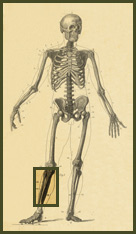Tibia
 The tibia and fibula provide the structural support of the lower portion of the leg with the tibia being the major weight bearing bone. The top of the tibia has two concave surfaces and makes up the lower portion of the knee joint. This portion of the tibia is known as the tibial plateau. The tibia is a somewhat tubular structure that runs from the tibial plateau above to the distal tibia (tibial plafond) below. The plafond makes up the upper portion of the ankle joint.
The tibia and fibula provide the structural support of the lower portion of the leg with the tibia being the major weight bearing bone. The top of the tibia has two concave surfaces and makes up the lower portion of the knee joint. This portion of the tibia is known as the tibial plateau. The tibia is a somewhat tubular structure that runs from the tibial plateau above to the distal tibia (tibial plafond) below. The plafond makes up the upper portion of the ankle joint. Many fractures of the tibia require operative stabilization. Fractures of the tibial shaft are most commonly stabilized with a metal rod placed in the central medullary canal, although several other methods are used depending on specific injury and patient characteristics. Fractures of the top (a tibial plateau fracture) and bottom (a tibial pilon fracture) portions of the tibia are most commonly stabilized with either plate and screw fixation or external fixation, again depending on specific injury and patient characteristics.
Because the inner portion of the tibia is located just beneath the skin, the treatment plan for all injuries involving this region must not only take into consideration the injury to the bone, but also the condition of the surrounding soft tissues (the so called “zone of injury”). Of all the operatively treated fractures in the human skeleton, the tibia is fraught with the most disastrous potential complications. These complications include: poor healing of bone, severe soft tissue problems, deep infection, bone infection (osteomyelitis), bone loss, nerve and artery injury and complications that can result in loss of a substantial portion of the limb (amputation).
Because of the potentially devastating consequences of tibia fractures, it is of paramount importance to choose a surgeon with vast experience. With proper treatment, even the most severe injuries of the lower leg can be healed and the patient’s quality of life can be significantly improved or returned to normal.
Tibia Problems Treated by Dr. Brinker*
|
Problem Types |
Number of Surgical Cases |
|
|
Fracture Nonunions |
563 |
|
|
Infected Nonunions |
117 |
|
|
Deformities |
242 |
|
|
Complex Fractures |
335 |
|
|
Bone Infections |
144 |
|
|
Periprostetic Fractures/
|
14 |
|
|
Limb Lengthening |
72 |
*This chart does not represent all of Dr. Brinker's Cases.


